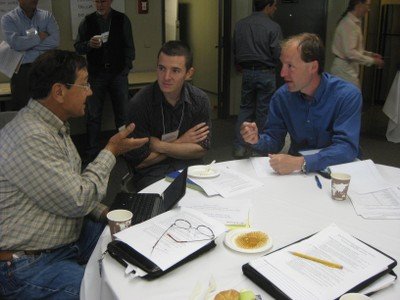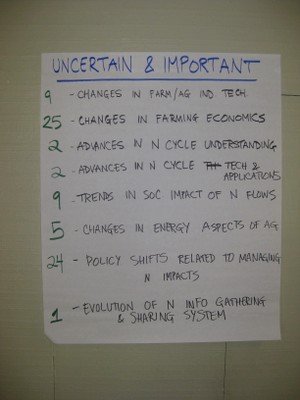Nitrogen in California: four futures
Changes in farming economics and shifts in public policy are the two great unknowns for the future of nitrogen management in California agriculture.
This is what a group of big-picture thinkers and agricultural experts concluded as part of a scenarios exercise hosted by the California Nitrogen Assessment, a project of the Agricultural Sustainability Institute at UC Davis.

- Al Medvitz, Antoine Champetier, and Ed Hard discuss nitrogen.
After the group decided on the two big uncertainties of economics and policy, they broke into four teams that mapped out different scenarios based on these uncertainties.
One group mapped a highly regulated, economically unstable future, where farming largely moves out of California. Another envisioned a highly regulated future that results in a much cleaner environment, but technical outreach and compliance assistance helps agriculture remain viable. A third grouped mapped out an unregulated future with difficult economics, but concluded that even without regulation, consumer demand would force farmers to clean up or better manage nitrogen pollution. The final group created a farmers' paradise of low regulation but excellent economics, which led to technological innovation and incentives to reduce nitrogen pollution, while keeping California agriculture competitive and productive.

- A list of uncertain and important factors impacting nitrogen management in California agriculture. Participants voted on which were the most uncertain and important.
This scenarios work helps ground our assessment in the reality of what our stakeholders see as key aspects of the future of nitrogen management in California: economics, policy, societal impacts, and technical options. It also brings together stakeholders from diverse perspectives, enabling them to find common ground and discuss the big uncertainties facing agriculture in our state.
